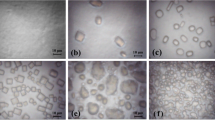Abstract
Ion transport in the new three-dimensional network polymer electrolytes that are completely amorphous in the solid state has been studied on the example of the matrix model with a monomer—polyethylene glycol diacrylate, cross-linked by radical polymerization. The nature of ionic conductivity in solid polymer electrolytes based on polyethylene glycol diacrylate at different concentrations of salt LiClO4 was studied by methods of electrochemical impedance, differential scanning calorimetry analysis, Fourier transform infrared spectroscopy and quantum chemical modeling. The maximum value of conductivity in the range of 20–100 °C is realized at 20 wt% content of LiClO4. The reason for the low conductivity of the SPE studied is the small degree of dissociation of contact ion pairs. At the increase in the salt content associates of contact pairs Li+ClO −4 , dimers and trimers (at LiClO4 >20 wt%) are formed. The appearances of trimers are accompanied by a decrease in conductivity due to lowering of contact pair content.










Similar content being viewed by others
References
Gray FM (1997) Polymer electrolytes. The Royal Society of Chemistry, Cambridge
Chandrasekhar V (1998) Adv Polym Sci 135:139–205
Huggins RA (2009) Advanced batteries. Springer Science Business Media, New York
Irzhak VI, Rozenberg BA, Enikolopyan NS (1979) Network polymers: Synthesis, structure, properties. Nauka, Moscow (in Russian)
Hiemenz PC (1984) Polymer chemistry: the basic concepts. Basel, New York
Park HG, Ryu SW (2010) Polym Korea 34:357–362
Tang DG, Liu JH, Ci YX, Qi L (2005) Acta Phys Chim Sin 21:1263–1268
Kang WC, Park HG, Kim KC, Ryu SW (2009) Electrochim Acta 54:4540–4544
Caillon-Caravanier M, Claude-Montigny B, Lemordant D, Bosser G (2003) Solid State Ionics 156:113–127
Hashmi SA, Kumar A, Tripathi SK (2007) J Phys D Appl Phys 40:6527–6534
Vondrak J, Reiter J, Velicka J, Klapste B, Sedlarikova M, Dvorak J (2005) J Power Sources 146:436–440
Ramesh S, Ang GP (2010) Ionics 16:465–473
Reiter J, Vondrak J, Micka Z (2005) Electrochim Acta 50:4469–4476
Cho BW, Kim DH, Lee HW, Na BK (2007) Korean J Chem Eng 24:1037–1041
Lee KH, Lim HS, Wang JH (2005) J Power Sources 139:284–288
Zhou S, Kim D (2010) Polym Adv Technol 21:797–801
Lin H, Wagner EV, Swinnea JS, Freeman BD, Pas SJ, Hill AJ, Kalakkunnath S, Kalika DS (2006) J Membr Sci 276:145–161
Yarmolenko OV, Efimov ON, Kotova AV, Matveeva IA (2003) Russ J Electrochem 39:513–519
Yarmolenko OV, Baskakova YUV, Tulibaeva GZ, Bogdanova LM, Dzhavadyan EA, Komarov BA, Surkov NF, Rozenberg BA, Efimov ON (2009) Russ J Electrochem 45:101–107
Ishmukhametova KG, Yarmolenko OV, Bogdanova LM, Rozenberg BA, Efimov ON (2009) Russ J Electrochem 45:558–563
Marinin AA, Khatmullina KG, Volkov VI, Yarmolenko OV (2011) Russ J Electrochem 47:717–725
Khatmullina KG, Yarmolenko OV, Bogdanova LM (2010) Polym Sci Ser A Polym Phys 52:1327–1333
Abbrent S (2000) Lithium ion interactions in polymer gel electrolytes: effects on structure, dynamics and morthology. Doctoral thesis, Acta Universitatis Upsaliensis, Uppsala
Abbrent S, Lindgren J, Tegenfeldt J, Wendsjo A (1998) Electrochim Acta 43:1185–1191
Wang FM, Lee JT, Cheng JH, Cheng ChSh, Yang ChR (2009) J Solid State Electrochem 13:1425–1431
Reiche A, Tubke J, Sandner R, Werther A, Sandner B, Fleischer G (1998) Electrochim Acta 43:1429
Itoh T, Mitsuda Y, Ebina T, Uno T, Kubo M (2009) J Power Sources 189:531–535
Golodnitsky D, Kovarsky R, Mazor H, Rosenberg Y, Lapides I, Peled E, Wieczorek W, Plewa A, Siekierski M, Kalita M, Settimi L, Scrosati B, Scanlon LG (2007) J Electrochem Soc 154:A547–A553
Perdew P, Burke K, Ernzerhof M (1996) Phys Rev Lett 77:3865–3868
Laikov DN (1997) Chem Phys Lett 281:151–156
Siqueira LJA, Ribeiro MCC (2005) J Chem Phys 122:194911–194918
Ducasse L, Dussauze M, Grondin J, Lassegues JC, Naudin C, Servant L (2003) Phys Chem Chem Phys 5:567–574
Linden D, Reddy TB (eds) (2002) Handbook of batteries (3rd edn.) McGraw-Hill, New York
Dey A, Kagan S, De SK (2010) J Phys Chem Solids 71:329–335
Sim LH, Gan SN, Chan CH, Yahya R (2010) Spectrochim Acta Part A 76:287–292
Martinez-Haya B, Hurtado P, Hortal AR, Hamad S, Steill JD, Oomens J (2010) J Phys Chem A 114:7048–7054
Musharaf Ali S, Maity DK, De S, Shenoi MRK (2008) Desalination 232:181–190
De S, Boda A, Ali SM (2010) J Mol Struct (THEOCHEM) 941:90–101
Johansson P, Tegenfeldt J, Lindgren J (1999) Polymer 42:4399–4406
Dhuaml NR, Gejji SP (2006) Theor Chem Accounts 115:308–321
Borodin O, Smith GD (1998) Macromolecules 31:8396–8406
Duan Y, Halley JW, Curtiss L, Redfern P (2005) J Chem Phys 122:054702–054709
Mao G, Saboungi ML, Price DL, Badyal YS, Fischer HE (2001) Europhys Lett 54:347–353
Robitaille CD, Fauteux D (1986) J Electrochem Soc 133:315–325
Henderson WA, Brooks NR (2003) Inorg Chem 42:4522–4524
Baboul AG, Redfern PC, Sutjianto A, Curtiss LA (1999) J Am Chem Soc 121:7220–7227
Acknowledgment
The authors thank Dr. Baskakov S.A. for measuring of the FTIR spectra. This work was supported by the grant of the Russian Foundation for Basic Research no. 10-03-00862.
Author information
Authors and Affiliations
Corresponding author
Rights and permissions
About this article
Cite this article
Yarmolenko, O.V., Khatmullina, K.G., Tulibaeva, G.Z. et al. Towards the mechanism of Li+ ion transfer in the net solid polymer electrolyte based on polyethylene glycol diacrylate–LiClO4 . J Solid State Electrochem 16, 3371–3381 (2012). https://doi.org/10.1007/s10008-012-1781-9
Received:
Revised:
Accepted:
Published:
Issue Date:
DOI: https://doi.org/10.1007/s10008-012-1781-9



